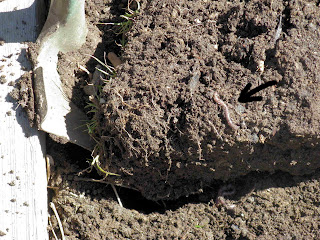 If you didn’t prepare soil in the early part of March when it was dry, think twice about when to do it now. Two snowstorms on the 19th and 23rd (see raised bed photo right) each left my Denver garden with an inch of water, 2 inches total in less than a week. Heavy, spring snows can bring a lot of welcome moisture to gardens when snow melts (photo below left) but can interfere with cultivating soil.
If you didn’t prepare soil in the early part of March when it was dry, think twice about when to do it now. Two snowstorms on the 19th and 23rd (see raised bed photo right) each left my Denver garden with an inch of water, 2 inches total in less than a week. Heavy, spring snows can bring a lot of welcome moisture to gardens when snow melts (photo below left) but can interfere with cultivating soil.Clay soils are especially sensitive to tilling at improper moisture content. They should be tilled at medium moisture, not too wet and not too dry. Tilling when too wet can create clods that take years to disperse on some clay soil types.

To check moisture, take a handful of soil and gently squeeze into a ball. If the ball crumbles when poked with a finger, it can be tilled. If the ball only reshapes with the pressure of poking, it’s too wet. Wait for it to dry more. With some clay soils there may be only a few days when soil is at the proper moisture content. If spring snows or rain are frequent, planting may be delayed.
Very wet soils are also easily compacted. Stay out of the garden when soil is wet. Water acts as a lubricant allowing soil particles to more easily slide over each other. Don’t compact soil that you worked so hard to make loose by walking in a wet garden.
One other moisture related matter is worth mentioning. Wet soils warm more slowly because the sun’s energy is used in evaporating water rather than in raising soil temperature. Cold soils will delay planting further.
Photo credit: Snowy spring raised bed gardens, both Carl Wilson

.jpg)








